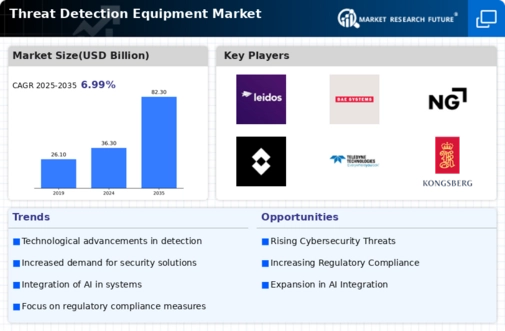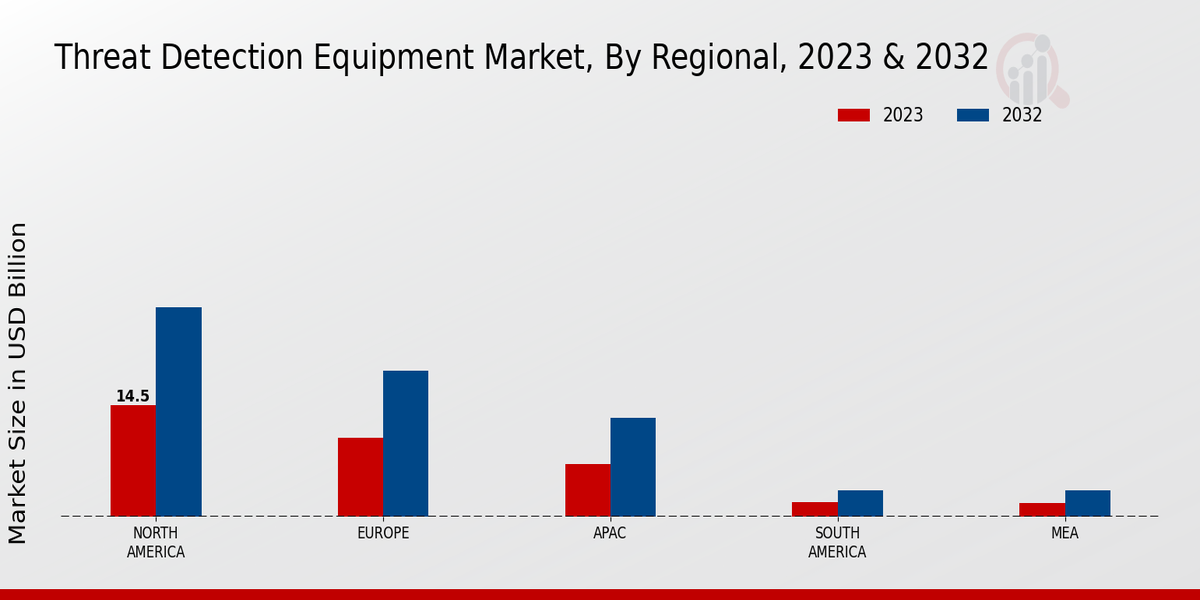Market Growth Projections
The Global Threat Detection Equipment Market Industry is projected to experience substantial growth over the coming years. With a market value anticipated to reach 36.3 USD Billion in 2024 and further expand to 82.3 USD Billion by 2035, the industry is on a promising trajectory. The compound annual growth rate of 7.73% from 2025 to 2035 underscores the increasing demand for advanced detection technologies. This growth is likely fueled by a combination of factors, including rising security concerns, technological advancements, and regulatory compliance, all contributing to a robust market environment.
Increasing Global Security Concerns
The Global Threat Detection Equipment Market Industry is experiencing growth driven by escalating security concerns across various sectors. Governments and organizations are increasingly investing in advanced threat detection technologies to safeguard against potential attacks. For instance, the rise in terrorism and cyber threats has prompted nations to enhance their security measures. This trend is reflected in the projected market value of 36.3 USD Billion in 2024, indicating a robust demand for innovative detection solutions. As threats evolve, the need for sophisticated equipment becomes paramount, thereby propelling the market forward.
Regulatory Compliance and Standards
The Global Threat Detection Equipment Market Industry is significantly influenced by regulatory compliance and standards set by governments and international bodies. Organizations are mandated to adhere to stringent security regulations, which necessitates the adoption of reliable detection equipment. For instance, the implementation of the National Institute of Standards and Technology guidelines compels companies to invest in advanced threat detection solutions. This regulatory landscape not only drives demand but also fosters innovation within the industry. As compliance becomes increasingly critical, the market is poised for sustained growth, reflecting the importance of adhering to established security protocols.
Rising Investment in Defense and Security
Increased investment in defense and security by governments worldwide is a key driver of the Global Threat Detection Equipment Market Industry. Nations are allocating substantial budgets to enhance their security apparatus, particularly in response to evolving threats. For example, defense budgets are projected to rise, leading to greater procurement of advanced detection technologies. This trend is indicative of a broader commitment to national security, which is expected to bolster the market's growth trajectory. As defense spending continues to increase, the demand for sophisticated threat detection equipment is likely to follow suit, further solidifying the industry's position.
Growing Demand for Cybersecurity Solutions
The surge in cyber threats has catalyzed the demand for cybersecurity solutions within the Global Threat Detection Equipment Market Industry. Organizations are increasingly recognizing the importance of protecting their digital assets from cyberattacks, leading to heightened investments in threat detection technologies. The market is projected to grow at a compound annual growth rate of 7.73% from 2025 to 2035, reflecting the urgency to address cybersecurity challenges. As businesses strive to safeguard sensitive information, the integration of advanced detection equipment becomes essential, thereby driving the market's expansion.
Technological Advancements in Detection Equipment
Technological innovations play a crucial role in shaping the Global Threat Detection Equipment Market Industry. The integration of artificial intelligence, machine learning, and advanced sensors into detection systems enhances their effectiveness and efficiency. For example, AI-driven analytics can identify patterns and anomalies that traditional systems might overlook. This technological evolution is expected to contribute to the market's growth, with a projected value of 82.3 USD Billion by 2035. As organizations seek to leverage cutting-edge technology to improve their security infrastructure, the demand for advanced threat detection equipment is likely to surge.






















